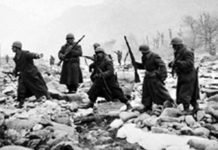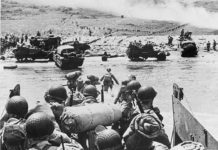North Africa and the Meditteranean were important fronts throughout World War II. However, for purposes of this article, my examination will be limited to the period between the German invasion of Crete in May 1941 and the removal of all Axis forces from North Africa two years later.
The fighting during these two years was comparable to a swinging pendulum. At times, it looked as though the Axis powers were about to rout the British. At other times, successful English counterattacks drove the Axis back to where they had started. In the end, victory was achieved by the Allies, in large part due to Ultra.
Before Ultra played a significant role in North Africa, though, it played one elsewhere in the Mediteranean. As a prelude to Operation Barbarossa, the Germans invaded the Balkans in the Spring of 1941. When they invaded Greece, Churchill transferred troops from North Africa. In the end, though, this made little difference. [1] As the British retreated toward Crete, the situation looked hopeless. Then, Ultra yielded priceless information.
On April 25, Hitler sent out orders for Operation Mercury, the airborne invasion of Crete. These orders were promptly deciphered by Bletchey Park. [2] While this was helpful, more significant information did not come until two weeks later, when a signal was intercepted detailing Germany’s entire battle strategy. [3] Throughout the battle, the British commander, General Bernard Freyberg, knew, through Ultra, German situation reports, reinforcement rates, and the identification of units landed on Crete. [4] Thus, over the course of the ten days that followed, the Germans suffered twice as many casualties as the British. [5] Yet in the end, the British were forced to evacuate the island. Ultra was almost enough to defeat the Germans, and had there been more British troops (or weapons), perhaps this would have happened. Crete proved to be a perfect example of the futility of having intelligence without adequate means to employ it.
Yet all was not for naught. Had the Germans been more successful in Crete, Malta surely would have been their next target. [6] Since the German invasion of Crete had cost the lives of many paratroopers, no more airborne operations were attempted by the Germans for the remainder of the war. As a result, the British retained their hold on Malta, from which they were able to sink a significant amount of Axis convoys. Between May and October 1941, the British sank an average of 180,000 tons (16%) of Axis shipping per month. [7] This percentage, although not appearing to be significant, was enough to cause Allied victory in Crusader. It deprived Rommel of the initiative. [8] He was not able to stockpile weapons, fuel, and explosives, all things that were necessary for a successful offensive. He had to postpone his planned offensive on Tobruk (a military target that he had failed to capture in his Spring 1941 offensive). As a result, Field-Marshal Claude Auchinleck was able to strike first with Crusader in November 1941. [9] Over the course of the following two months, the Germans were pushed back to the same position they had been when Rommel had arrived.
After the New Year, the Germans were able to limit convoy losses considerably through improved convoy methods, the torpedoing of several British battleships, the transfer of Luftflotte 2 and Fliegerkorps II from Russia to Sicily, and the transfer of U-Boats from the Atlantic. [10] As a result, supplies and reinforcements were able to get through to Rommel, which enabled him to launch an offensive on January 21, one that took the Allies by surprise. [11]
By the end of the month, the Germans had recovered almost all the ground they had lost in Crusader. This happened for a variety of reasons. Of primary importance was British lack of success in anti-convoy efforts. During the months of February and March, the British were only able to sink nine percent of the convoys, a figure which declined even further in April to less than one percent. [12] As a result, in May 1942, Rommel was able to preempt a planned Allied offensive with one of his.
Although Ultra revealed Rommel’s intentions a few days before the offensive, the British were slow to act upon the information. When Rommel struck on May 27, he achieved rapid success. A month later, Rommel pushed the British entirely out of Libya, conquered Tobruk, and continued on the offensive into Egypt. His offensive continued deep into Egypt, until he was suddenly stopped in July 1942 at El Alamein.
This was due largely to increased British success in sinking Axis convoys during the second half of 1942. The lack of sufficient supplies, mainly oil, restricted Rommel’s maneuvers in Alamein. [13] During the second half of 1942, the percentage of Axis shipping sunk was at least 20% for five of the six months. [14] At the end of September, Count Ciano, the Italian Foreign Secretary, was quoted as saying that “at this rate the African problem will automatically end since we shall have no more ships with which to supply Libya.” [15] In October, the month of the second battle of El Alamein, the percentage rose to a staggering 44 percent. No question, this success was in large part responsible for the tremendous Allied victory that followed.
On October 24, Field-Marshal Bernard Montgomery launched the Second Battle of El Alamein. The role the Ultra plaed was considerable. Through Ultra, Montgomery knew that the Axis forces had almost completely consumed their oil supplies. [16] Armed with this information, Montgomery hammered hard at Rommel’s forces, with the knowledge that Rommel was inhibited from launching major counter-attacks.
Two weeks after the British offensive was launched, America began its first major offensive of the war: Operation TORCH, which was a major success due to Ultra. Before General Dwight D. Eisenhower launched the operation on November 7, he was overly concerned about its security. Namely he feared that Hitler would “have one of his intuitions,” [17] and would have sent troops to anticipate the invasion. Because Hitler’s Enigma was being deciphered, Eisenhower was assured that this was not so. The invasion came as a total surprise. [18]
By the New Year, the English had driven Rommel’s Army out of Egypt and toward Tripoli. The Americans were safely ensconced in Morocco and Algeria. In most respects, the war in North Africa was coming to a quick end. This is aptly shown by a 90 percent drop in cargo disembarked between November and December. [19] With this figure, it seems obvious that four months later, the Axis lost all of North Africa.
North Africa demonstrated Ultra’s increasing effectiveness. The information that Ultra provided was instrumental in the near British success at Crete, and the British successes in Crusader and later in El Alamein. Thus it is often asked why it was that the North African campaign lasted more than two years, if the British had such an excellent source of information.
When contemplating this, one should consider that the best information in the world is useless, if adequate means are not available. Crete and the lack of British success anti-convoy operations during the first six months of 1942 are perfect examples. In many ways, without Ultra, it can be easily concluded that Rommel would have been successful in North Africa, and it was only due to Ultra that the Allies, over time, were able to defeat him.
Footnotes:
- [1] Gerhard L. Weinberg, A World At Arms, (NY: Cambridge University Press, 1995), 2nd ed., pp. 218-19.
- [2] Ronald Lewin, Ultra Goes To War, (NY: Mc-Graw Hill Book Co., 1978), p. 157.
- [3] Ralph Bennett, Ultra and Meditteranean Strategy, (NY: William Morrow, 1989), p. 54.
- [4] F.H. Hinsley, British Intelligence During the Second World War, (London: Her Majesty’s Stationary Office [HMSO], 1979), p. 420.
- [5] Bennett, p. 51.
- [6] Weinberg, p. 229.
- [7] Bennett, p. 71.
- [8] Ibid., p. 79.
- [9] Weinberg, p. 232.
- [10] Hinsley, v. 2., (London: HMSO, 1981), p. 325.
- [11] Weinberg, p. 348.
- [12] Ibid., p. 349.
- [13] Lewin, p. 266.
- [14] Hinsley, v. 2., p. 422.
- [15] Ibid., quoting David Richards, The RAF, 1939-45, v. 2., p. 231.
- [16] Bennett, p. 160.
- [17] Lewin, p. 271.
- [18] Weinberg, p. 431.
- [19] Ibid.








